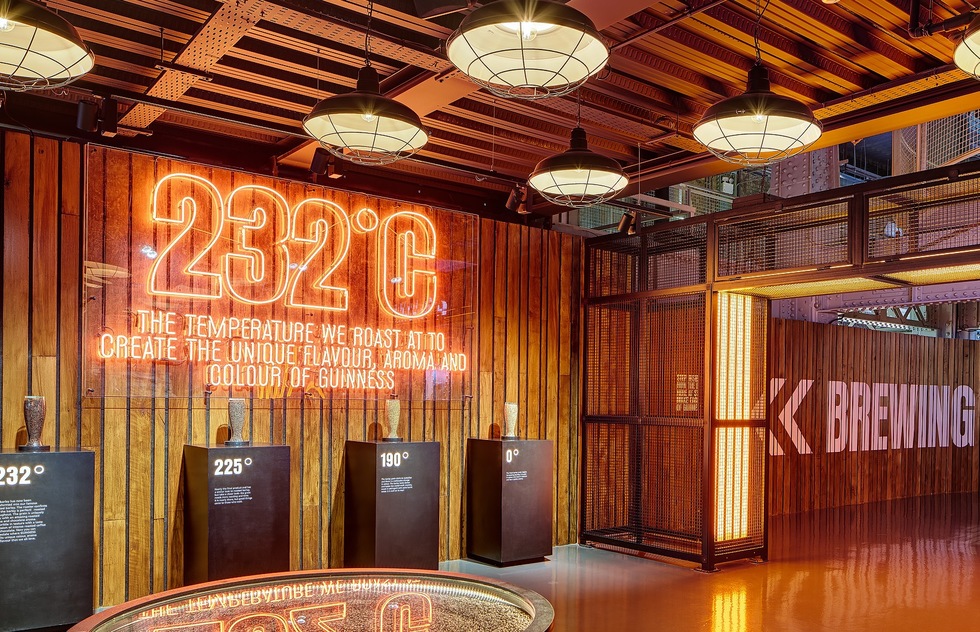The first Frommer’s guidebook, Europe on 5 Dollars a Day by Arthur Frommer, was published in 1957. In our series of Frommer’s flashbacks, we’re revisiting noteworthy places featured in the earliest Frommer’s books to see what’s changed and what has stayed the same in our 65 years of showing you around the globe.
Since opening in 2000, the Guinness Storehouse, a onetime fermentation plant turned temple to stout in western Dublin, has become the most visited attraction in Ireland, drawing in more than 1.7 million tourists each year—which is more people than the Irish capital has residents.
But the Storehouse wasn't the first place where Guinness enthusiasts could pay homage when they visited Dublin. For starters, there were the pubs (there will always be the pubs). Then there was the beer company's famed St. James's Gate brewery itself, which began allowing fans onto the property not too long after founder Arthur Guinness signed a 9,000-year lease for the land in 1759.
"There is a long tradition of welcoming visitors to St. James’s Gate, dating back to the mid-1800s," Guinness Storehouse archive manager Eibhlin Colgan told Frommer's in an email this week. "From the late 1800s to the 1950s, visitors to the brewery were transported around St. James’s Gate via the narrow gauge railway system on specially converted wagons."
 (Undated photo of the former visitor building at Dublin's Guinness Brewery | Copyright Guinness Archive, Diageo Ireland)
(Undated photo of the former visitor building at Dublin's Guinness Brewery | Copyright Guinness Archive, Diageo Ireland)
By the early 1900s, according to Colgan, a "Visitor's Reception building" across the road from the brewery's Front Gate employed two full-time guides. Then, as now, tours ended "with a sample of freshly brewed Guinness stout or porter from the Visitors’ Bar within the same building." The sample was "served direct from the cask in pewter tankards."
 (1960s photo of bartender pouring samples for attendees of the Guinness Brewery tour in Dublin | Copyright Guinness Archive, Diageo Ireland)
(1960s photo of bartender pouring samples for attendees of the Guinness Brewery tour in Dublin | Copyright Guinness Archive, Diageo Ireland)
The Guinness Brewery Tour Back in the Day
The Guinness brewery's first guidebook mention, Colgan reports, came in 1867. (It wasn't one of our publications.)
Exactly one century later, Frommer's author Beth Bryant took the brewery tour for Ireland on $5 a Day, which was evidently still a doable budget in 1967. Here's how Bryant described the experience:
 (Left to right: 1967 Guinness Brewery ad and 1968 Guinness Brewery invitation | Copyright Guinness Archive, Diageo Ireland)
(Left to right: 1967 Guinness Brewery ad and 1968 Guinness Brewery invitation | Copyright Guinness Archive, Diageo Ireland)
Colgan, the Guinness archivist, tells us the original visitors' building is now a branch of the Bank of Ireland. A new Guinness Visitors' Centre replaced the old one when a fresh facility opened in the Front Yard of St. James's Gate in 1975. That spot was later subsumed, along with the 1966 Brewery Museum, in the Guinness Hopstore, which opened in 1988.
Then a dozen years later along came the Guinness Storehouse. The Hopstore building is now owned by the government-funded Digital Hub, a cluster of technology and digital media companies. Colgan reports that the working mini model mentioned in the retro Frommer's write-up has not survived, which is a shame because that thing sounded adorable.
 (1966 photo of Guinness Brewery Museum in Dublin | Copyright Guinness Archive, Diageo Ireland)
(1966 photo of Guinness Brewery Museum in Dublin | Copyright Guinness Archive, Diageo Ireland)
The Guinness Storehouse Story
Housed in a 1904 industrial building, the Storehouse is considerably slicker than previous tourist attractions on Guinness property. The main exhibit spirals up seven floors centered on an atrium meant to resemble a giant pint glass.
The museum supplies an exhaustive account of company history as well as the beer-making process, detailing Guinness brewers' special way with hops, barley, and nitrogen bubbles. You'll learn more about yeast than you ever cared to know.
 (Credit: Guinness Storehouse)
(Credit: Guinness Storehouse)
But for all the glossy, high-tech tributes to roasted barley, the most entertaining feature has to be the large, nostalgic collection of Guinness advertising memorabilia on the third floor. Flocks of Guinness toucans and other corporate mascots tout the stout amid vintage print ads, TV commercials, and sometimes head-scratching slogans arguing for the product's effectiveness as a health drink or an antidote to drowsiness.
As ever, admission comes with a complimentary pint of Guinness, and you get to throw it back in the dazzling Gravity Bar on the top story, where floor-to-ceiling windows show off far-reaching views of Dublin.
 (Credit: Guinness Storehouse)
(Credit: Guinness Storehouse)
Completed just before the pandemic, a multimillion-euro renovation of the bar not only updated the interior design but also more than doubled the floor space and reconfigured the layout to improve crowd flow.
Of course, your time in the Gravity Bar should only supplement rather than replace a tour of Dublin's traditional pubs. Following the recommendations of Bryant, the 1967 Frommer's author, you can, for instance, pop into Peter's Pub at No. 1 Johnson Place.
 (Author photo of Beth Bryant, taken at what appears to be Dublin's Long Hall pub, from Ireland on $5 a Day, published by Frommer's in 1967)
(Author photo of Beth Bryant, taken at what appears to be Dublin's Long Hall pub, from Ireland on $5 a Day, published by Frommer's in 1967)
Peter's is still going strong, though you will not, these days, be able to repeat our author's impromptu evening in the company of Irish republican, folk singer, and literary matriarch Kathleen Behan (1889–1984), whose offspring included poet Brendan Behan (1923–1964).
"Get the girrel a drink!" Kathleen said upon meeting the Frommer's travel writer, according to the guidebook. "She knew Brendan in New York."
Naturally, the tale ends with a sing-along to "Don't Muck About with the Moon."






